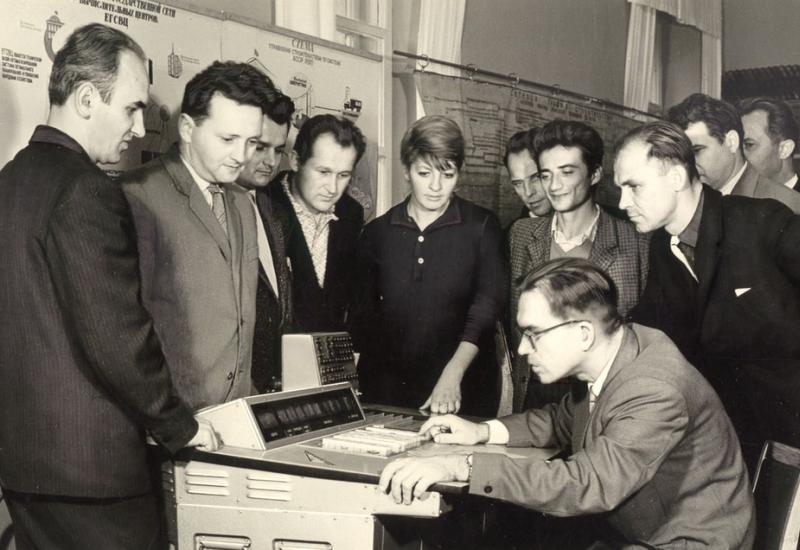A large number of unique exhibits, such as models of equipment, representing almost all the technical area, were collected at the State Polytechnic Museum at NTUU "KPI”. Many of them are of the age of more than a dozen years.
All these exhibits once worked as intended, each one has its own story and represents a moment of the history of technology. Our newspaper begins to acquaint readers with the most interesting exhibits. As information technology and equipment is rapidly developing, the first story is about electronic brain.
As you know, the first electronic brain appeared in the USA (1945), then in the UK. The first electronic brain in the Ukraine, USSR, continental Europe was established in Kiev (1951), the Institute of Electrical technology USSR Academy of Sciences led by academician Lebedev. His monument is installed at the SPM.
 The first computers were used for calculations in the field of military equipment (ballistic research). In 1952 the first national "Small electronic computing machine " (SECM) designed by Lebedev was virtually the only country, which solved the most important scientific and practical tasks in the field of thermonuclear processes (Ya.B.Zeldovych), space flight and rocketry (M.V.Keldysh, A.O.Dorodnitsyn, O.A.Lyapunov) of super-long lines system (Lebedev), probability theory (B.V.Hnedenko) etc. Further development of computer technology in our country is connected with Academician Glushkov, who was the founder of computer science in Ukraine.
The first computers were used for calculations in the field of military equipment (ballistic research). In 1952 the first national "Small electronic computing machine " (SECM) designed by Lebedev was virtually the only country, which solved the most important scientific and practical tasks in the field of thermonuclear processes (Ya.B.Zeldovych), space flight and rocketry (M.V.Keldysh, A.O.Dorodnitsyn, O.A.Lyapunov) of super-long lines system (Lebedev), probability theory (B.V.Hnedenko) etc. Further development of computer technology in our country is connected with Academician Glushkov, who was the founder of computer science in Ukraine.
In 7 years after the creation of the SECM, expansion of needs in the using the computer for mainstream computing and the circle of users caused the necessity of creating a relatively inexpensive electronic machines with a fairly simple user-friendly programming and control.
In 1959 V.M. Glushkov formulated a program of work on machines for engineering calculations with which he made a report at the All-Union Conference on Computer Science in Kiev. For 3 years a great job was done with the development of various aspects of computer theory and its implementation in specific developments. The main results are contained in the Glushkov‘s monograph "Synthesis of digital machines" (1961). For a series of works Glushkov was awarded the Lenin Prize (1964), which is the most prestigious in the USSR.
Under the direction of Glushkov (supervisor) and S.B.Pohrebynskoho (chief designer), the idea of personal cars for engineer was implemented in the electronic brain "Ray" in just 8 months. In 1963 mass production of computers "Ray" began at the instrument engineering plant built in Severodonetsk. Commercial production of computer technology in Ukraine began with machine "Ray" and control machines "Dnepr".
The machine was essentially a new word in the world, technically had a number of innovations, including metallized memory cards. It was the first consumer machine with so-called step firmware control (to which later received Glushkov's certificate), based only on the semiconductor elements. The ease of controlling it was achieved by field typesetting keyboards, which were made hardware supported by procedures such elementary functions. The input language of machine had already been somewhat close to normal mathematical language. In electronic brain 32 operations are structurally accomplished. The average time of add-type operations is 1000 op/sec and the average time of multiplication-type operations is 100 op/sec. "Ray" had pulse-potential element base, it applied upgraded diode-transformer control elements of general purpose machine "Dnepr".
One copy of the electronic brain "Ray", now stored in the SPM in "Informatics and Computer Science" section, was shown in the Museum of the Institute of Cybernetics, established by V.M.Glushkov in 1964. The machine had been stored for over 30 years there. Then the museum was closed, "Ray" got in the closet, and the priceless historic electronic brain got to us in 1998, when the State Polytechnic Museum opened.

